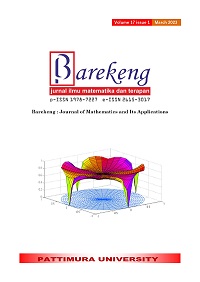DYNAMIC ANALYSIS OF THE MATHEMATICAL MODEL FOR THE CHOLERA DISEASE SPREAD INVOLVING MEDICATION AND ENVIROMENTAL SANITATION
Abstract
This study aims to analyze the mathematical model of the cholera disease spread involving medicationnd environmental sanitation. The model was analyzed by determining the equilibrium point and the basic reproduction number. The next step was to analyze the equilibrium point, sensitivity, and simulate numerically. Analysis of the stability of the disease-free and endemic equilibrium points usedhe Routh-Hurwitz criteria and the Castillo-Chaves and Song Theorem. The Analysis resultf the model produced two equilibrium points; namely the disease-freequilibrium point for local asymptotic stability and the endemic equilibrium point for local asymptotic stability if . Furthermore, the sensitivity analysis indicated the most sensitive parameters for basic reproductive number changes in succession are the parameters for natural birth rates , the transmission rate of bacteria from the environment to humans , the saturated concentration of bacteria in water , an increase in the bacterial population caused by environmental pollution rate by humans . Numerical simulations suggest an increase to give vaccine can contribute to slowing the transmission of cholera where as the reduction of a vaccine able to promote the transmission of cholera diseases.
Downloads
References
WHO, “Drop in cholera cases worldwide, as key endemic countries report gains in cholera control,” WHO, 2019. .
B. A. Anggaraditya, “Menekan Laju Penyebaran Kolera Di Asia Dengan 3Sw (Sterilization, Sewage, Sources, and Water Purification),” Intisari Sains Medis, vol. 3, no. 1, p. 83, 2015, doi: 10.15562/ism.v3i1.71.
S. Side, S. Sukarna, and G. T. Asfarina, “Analisis Kestabilan Penyebaran Penyakit Kolera Menggunakan Model SEIRS dengan Vaksinasi dan Faktor Treatment,” J. Math. Comput. Stat., vol. 1, no. 2, p. 155, 2019, doi: 10.35580/jmathcos.v1i2.9239.
M. Z. Ndii, “Pemodelan Matematika: Dinamika Populasi dan Penyebaran Penyakit.” p. 133, 2018.
A. R. Nuha and R. Resmawan, “Analisis Model Matematika Penyebaran Penyakit Kolera Dengan Mempertimbangkan Masa Inkubasi,” J. Ilm. Mat. dan Terap., vol. 17, no. 2, pp. 212–229, 2020, doi: https://doi.org/10.22487/2540766X.2020.v17.i2.15200.
N. S. Abdul, L. Yahya, R. Resmawan, and A. R. Nuha, “Dynamic Analysis of the Mathematical Model of the Spread of Cholera With Vaccination Strategies,” BAREKENG J. Ilmu Mat. dan Terap., vol. 16, no. 1, pp. 281–292, 2022, doi: 10.30598/barekengvol16iss1pp279-290.
F. Minggani, “Penerapan Transformasi Laplace Modifikasi Pada Persamaan Diferensial,” vol. 2, no. 1, pp. 91–98, 2019.
X. Tian, R. Xu, and J. Lin, “Mathematical analysis of a cholera infection model with vaccination strategy,” Appl. Math. Comput., vol. 361, pp. 517–535, 2019, doi: 10.1016/j.amc.2019.05.055.
E. Eric, Kokomo. Yves, “Mathematical analysis and numerical simulation of an age-structured model of cholera with vaccination and demographic movements,” vol. 45, pp. 142–156, 2019, doi: doi.org/10.1016/j.nonrwa.2018.06.011.
M. Manaqib, F. Irma, and B. F. Apriyanto, “Model Matematika Penyakit Kolera Melalui Kontak Antar Individu , Sumber Air , dan Lalat,” pp. 79–92, 2022.
E. Dangbé, D. Irépran, A. Perasso, and D. Békollé, “Mathematical modelling and numerical simulations of the influence of hygiene and seasons on the spread of cholera,” Math. Biosci., vol. 296, pp. 60–70, 2018, doi: 10.1016/j.mbs.2017.12.004.
V. S. Erturk and P. Kumar, “Dynamics of cholera disease by using two recent fractional numerical methods,” Math. Model. Numer. Simul. with Appl., vol. 1, no. 2, pp. 102–111, 2021, doi: 10.53391/mmnsa.2021.01.010.
A. A. S. Rashid, F. Jarad, “Numerical investigation of fractional-order cholera epidemic model with transmission dynamics via fractal–fractional operator technique,” Chaos, Solitons & Fractals, vol. 162, 2022, doi: https://doi.org/10.1016/j.chaos.2022.112477.
D. Baleanu, F. A. Ghassabzade, J. J. Nieto, and A. Jajarmi, “On a new and generalized fractional model for a real cholera outbreak,” Alexandria Eng. J., vol. 61, no. 11, pp. 9175–9186, 2022, doi: 10.1016/j.aej.2022.02.054.
Y. He and Z. Wang, “Stability Analysis and Optimal Control of a Fractional Cholera Epidemic Model,” Fractal Fract., vol. 6, no. 3, 2022, doi: 10.3390/fractalfract6030157.
Z. Mukandavire, A. Tripathi, C. Chiyaka, G. Musuka, F. Nyabadza, and H. G. Mwambi, “Modelling and Analysis of the Intrinsic Dynamics of Cholera,” Differ. Equations Dyn. Syst., vol. 19, no. 3, pp. 253–265, 2011, doi: 10.1007/s12591-011-0087-1.
Kementerian Kesehatan RI, “Pedoman Pengobatan Dasar di Puskesmas 2007,” pp. 1–247, 2007.
Kementerian Kesehatan RI, “Buku Pedoman Penyelidikan dan Penanggulangan Kejadian Luar Biasa Penyakit Menular dan Keracunan Pangan (Pedoman Epidemiologi Penyakit),” Kementeri. Kesehat. Republik Indones., vol. Edisi Revi, no. 2017, pp. 1–251, 2017.
N. M. K. Yudhi, “Analisis Kestabilan Model Penyebaran Penyakit Hepatitis a Dengan Vaksinasi Dan Sanitasi,” Bimaster Bul. Ilm. Mat. Stat. dan Ter., vol. 8, no. 2, pp. 327–334, 2019, doi: 10.26418/bbimst.v8i2.32490.
P. van den Driessche and J. Watmough, “Reproduction numbers and sub-threshold endemic equilibria for compartmental models of disease transmission,” Math. Biosci., vol. 180, no. 1–2, pp. 29–48, Nov. 2002, doi: 10.1016/S0025-5564(02)00108-6.
S. B. Castillo-Chaves C, “Dynamic Models of Tuberculosis and Their Applications,” Am. Inst. Math. Sci., vol. 1, no. (2), pp. 361–404, 2004, doi: : 10.3934/mbe.2004.1.361.
J. M. H. & J. M. C. Nakul Chitnis, “Determining Important Parameters in the Spread of Malaria Through the Sensitivity Analysis of a Mathematical Model,” springer.com, 2008. .
R. Resmawan and L. Yahya, “Sensitivity Analysis of Mathematical Model of Coronavirus Disease (COVID-19) Transmission,” CAUCHY J. Mat. Murni dan Apl., vol. 6, no. 2, pp. 91–99, 2020, doi: 10.18860/ca.v6i2.9165.
Copyright (c) 2023 Resmawan Resmawan, Lailany Yahya, Sri Lestari Mahmud, Agusyarif Rezka Nuha, Nazrilla Hasan Laita

This work is licensed under a Creative Commons Attribution-ShareAlike 4.0 International License.
Authors who publish with this Journal agree to the following terms:
- Author retain copyright and grant the journal right of first publication with the work simultaneously licensed under a creative commons attribution license that allow others to share the work within an acknowledgement of the work’s authorship and initial publication of this journal.
- Authors are able to enter into separate, additional contractual arrangement for the non-exclusive distribution of the journal’s published version of the work (e.g. acknowledgement of its initial publication in this journal).
- Authors are permitted and encouraged to post their work online (e.g. in institutional repositories or on their websites) prior to and during the submission process, as it can lead to productive exchanges, as well as earlier and greater citation of published works.






1.gif)



